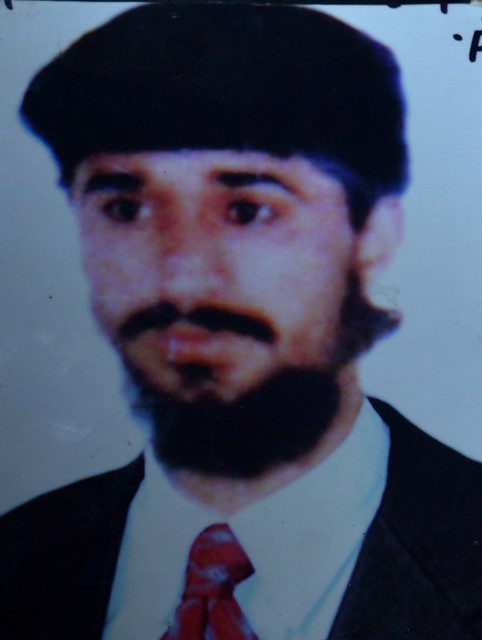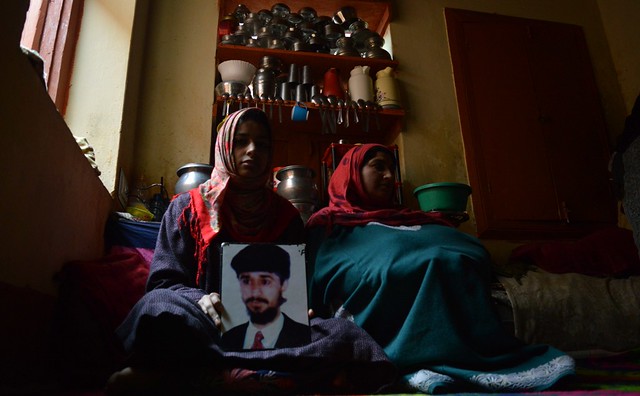In the second of the five personal stories of half widows, Raqib Hameed Naik narrates the story of Naseema Dar.
Tengpora (Srinagar): On April 19, 1997, the Dar family of Mumin Abad, Tengpora, Srinagar, had had a tiring day. It was the second day of Eid-al-Adha, after visiting neighbours and relatives, the family of Razzaq Dar decided to call it an early day and his son, 34-year-old Mehraj-ud-din Dar, followed his father’s orders.

Mehraj-ud-din had been a witness to, and a participant in, Kashmir’s uprising in the early 90s. Like thousands of other youth, he too had joined the Jammu Kashmir Liberation Front (JKLF). He was later caught up by the security forces, sent to jail and later released in 1994 after serving his term. As soon he came out of jail, he decided to leave behind his past on the insistence of his wife Naseema Begum and opened a shoe shop near his locality, which became the sole source of earning for his family. But the ex-militant could not shake off his past, and this was to play a detrimental on the night of April 19.
Just as Mehraj had thought he had dozed off, he heard the sounds of jackboots passing through the alleys which were close to his house. Within a few minutes, the air was heavy with cries from a neighbouring house, where army men were interrogating the occupants. As the cries intensified, the Dar family got more restless. They knew that this could not augur well for them, and grew restless with passing time. Mehraj feared the worst; he had all the reasons to do so.
It was just nine months ago that Mehraj was blessed with a baby boy after eight years of marriage. The hour needle touched 3, and as his child slept next to him and his wife, the sound of boots intensified. Within the next few minutes, Mehraj and Nassema’s life turned for the worst, forever. The 20th Grenadiers, Rashtriya Rifle under the command of a Major, were carrying search operations in Tengpora, localities and had just knocked down the door of the house of the Dars.
The Army men rounded up all family members and locked them inside a single room. The pattern was eerily similar to that of the story of Safiya Azad .
He was taken into another room where he was asked the most common question posed to every arrested Kashmiri in the 90s: Samaan kahaan hain? (Where is the ammunition)” As Mehraj replied in negative to their repeated inquiries, the Army men called his father and asked him for hot water and chilly power to be used in torturing him.
The torture went on unabated for two hours. It was only after the call for Azan, call for prayers in early morning, that the Army men received a message on their wireless communicating devices to return back to the camp located in Boatmen colony in Bemina, Srinagar.

All of Mehraj’s family members: father, mother, sisters and a brother, who had been locked inside, managed to free themselves after breaking their door but he had already taken away by army men to their camp. The day marked the start of intensive search for Mehraj which continued for over a decade. “After he was picked up by the army, I went to their camp continuously for 10 days but they didn’t even acknowledge that they have picked him up,” says Naseema, the half-widow of Mehraj. Again, the similarity with the case of Safiya Azad is visible. She too, had to suffer the indignity of watching army officials not even acknowledging that her husband was detained, let alone being tortured.
“Later when they realised I am going to come again and again they told me that they will arrange a meeting with my husband but they never did,” added Naseema.
Naseema’s search for her husband never came to halt as she continued to look for him in different army camps in Uri, Baramulla, Pattan and even in Tihar jail but every time to return back with similar replies, “Wo Yahan Nahi Hai(He isn’t here).”
In 2000, the case went in State Human Rights Commission and after six years, the commission directed the government to pay Rs 1 Lakh to the victim’s family and a government job. This was of course, out rightly rejected by the family. “My father-in-law had said to the commission members that ‘give me your son and take Rs 2 lakh’,” says Naseema.
The disappearance of Mehraj marked the start of hardships for Naseema, as she was left alone to raise and support the education of his son and a daughter, who was born some months after his disappearance.
Months after the disappearance of his husband, Naseema was asked by her father-in-law to leave the house. As we had mentioned in Part 2 of the series, this is a common problem faced by many half widows. Naseema returned to her parents in Mansbal and they helped her financially apart from of course, the emotional support. It was only in 2005 when his brother-in-law came to her rescue. “He came to my parents place for inviting me for his marriage. I went there along with my kids. After marriage, he and his wife asked us to live with them. It was only then that my father-in-law gave me a single room to sleep and cook out of the eight-room house.”

Naseema’s son Sahil Mehraj, who at the time of his father’s disappearance was an infant, is now a 17-year-old teenager and completed his matriculation exams recently. He is currently working as salesmen in a local shop which fetches him Rs 1,500 per month. Her daughter Shabnum Mehraj, 16, is studying in 10th standard in a local school.
“We have no other source of income. Initially I used to get help from my parents, then some neighbours used to help us monetarily but that wasn’t sufficient to completely cover the expenses of running this house because my father-in-law don’t helps us financially in any way. It is difficult to survive with so little money, but we hardly have a choice,” says Naseema.
She was told by her family members and in laws to remarry, but she choose to live as ‘half widow’ believing that someday her husband will return and reunite with his family.”All through these years I waited for my husband but he didn’t return.
Now I have lost hope, my only request to the government is: if he is alive hand him over to us. If he is in Jail, let us speak with him. If he is dead, show us his grave,” says Naseema amid tears.
Naseema remembers visiting a senior National Conference leader, Ali Mohammad Sagar to seek his help in finding his missing husband. “When I went to ask him for his help, he told us unsympathetically that he might have gone over to Pakistan and we must stop our search for him. But when we showed him the copy of FIR, he asked us to get out from his chamber.”

Her only source of comfort, or rather, sharing the pain, is the Pratap Park rally she attends on the 10th of the every month with APDP .
Some months back, Naseema filed a fresh litigation in a Srinagar Court to reinvestigate the disappearance of her husband with the help of APDP. But Naseema and her kids are anticipating the return of Mehraj, even though it has now been close to 19 years. “We can only hope that he is alive, but God knows better where and what has happened with him,” she adds
Read Part-I here: Armed with a pictures that tell a thousand words: The protestors of Pratap Park
Read Part-II here: The half widows of Kashmir: A story of endless wait and hardships
Watch Short Film here: Half Widows of Kashmir
Read Part-III here: Married at 17, ‘Half widowed’ at 18: Safiya Azad continues to wait even after 23 years

